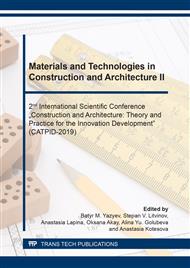[1]
M.Yu. Elistratkin, M.I. Kozhukhova, Analysis of the factors of increasing the strength of the non-autoclave aerated concrete, Construction Materials and Products. 1 (1) (2018) 59 – 68.
DOI: 10.34031/2618-7183-2018-1-1-59-68
Google Scholar
[2]
T.V. Dmitrieva, V.V. Strokova, A.A. Bezrodnykh, Influence of the genetic features of soils on the properties of soil-concretes on their basis, Construction Materials and Products. 1 (1) (2018) 69 – 77.
DOI: 10.34031/2618-7183-2018-1-1-69-77
Google Scholar
[3]
Yu.V. Pukharenko, D.G. Letenko, V.A. Nikitin, V.I. Morozov, Obtaining the nanomodifier for cement composites based on the dealtom, carbon nanotubes, Materials Physics and Mechanics. 31 (2017) 59-62.
Google Scholar
[4]
A.N. Volodchenko, Development composition of thermal insulation materials autoclave curing based on clay raw materials, Bulletin of BSTU named after V.G. Shukhov. 2 (2017) 162-167.
DOI: 10.12737/24452
Google Scholar
[5]
J. Brozovsky. Rebound hammer tests of calcium silicate bricks—effects of internal compressive stress on measurement results, Applied Mechanics and Materials. 595 (2014) 155-158.
DOI: 10.4028/www.scientific.net/amm.595.155
Google Scholar
[6]
S.-A.Y. Murtazaev, M. Salamanova, S. Zaurbekov, R. Bisultanov, M. Nakhaev, Composite Binders with the Use of Fine Raw Materials of Volcanic Origin, International journal of environmental & science education. 11 (18) (2016) 12711-12716.
Google Scholar
[7]
N.I. Alfimova, E.E. Shadskiy, R.V. Lesovik, M.S. Ageeva, Organic-mineral modifier on the basis of volcanogenic-sedimentary rocks, International Journal of Applied Engineering Researc. 10 (24) (2015). 45131-45136.
Google Scholar
[8]
L.A. Suleymanova, K.A. Kara, M.V. Malyukova, K.A. Suleymanov, The influence of technological factors on the basic properties of vibropressed concrete paving slabs, Research Journal of Applied Sciences. 9 (11) (2014) 874-878.
Google Scholar
[9]
A.A. Volodchenko, V.S. Lesovik, A.N. Volodchenko, L.H. Zagorodnjuk, Improving the efficiency of wall materials for «green» building through the use of aluminosilicate raw materials, International Journal of Applied Engineering Research. 10 (24) (2015) 45142-45149.
DOI: 10.4028/www.scientific.net/msf.974.20
Google Scholar
[10]
A.A. Volodchenko, V.S. Lesovik, A.N. Volodchenko, L.H. Zagorodnjuk, Influence of the inorganic modifier structure on structural composite properties, International Journal of Applied Engineering Research. 10 (19) (2015) 40617-40622.
Google Scholar
[11]
Ali Olad, Polymer, Clay Nanocomposites, Advances in Diverse Industrial Applications of Nanocomposites, InTech, (2011) 113–138.
DOI: 10.5772/15657
Google Scholar
[12]
P. Kiliaris, C.D. Papaspyrides, Polymer layered silicate (clay) nanocomposites: An overview of flame retardancy, Progress in Polymer Science. 35 (2010) 902–958.
DOI: 10.1016/j.progpolymsci.2010.03.001
Google Scholar
[13]
A. Elamri, K. Abid, S. Dhouib, F. Sakli, Morphological and mechanical properties of nanoclay coated fabric, American Journal of Nano Research and Application. Special Issue: Nanocomposites Coating and Manufacturing. 3 (4-1) (2015) 17-24.
Google Scholar
[14]
Danielle Klimesch, Abhi Ray, Evaluation of phases in a hydrothermally treated CaO-SiO2-H2O system, Journal of Thermal Analysis and Calorimetry. 70 (3) (2002) 995-1003.
Google Scholar
[15]
S Bernstein, Thomas Karl Fehr, The formation of 1.13 nm tobermorite under hydrothermal conditions: 1. The influence of quartz grain size within the system CaO–SiO2–D2O, Progress in Crystal Growth and Characterization of Materials. 58 (2-3) (2012) 84-91.
DOI: 10.1016/j.pcrysgrow.2012.02.006
Google Scholar


